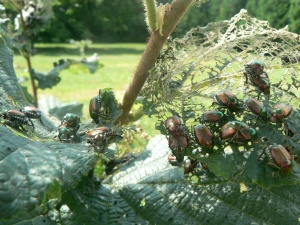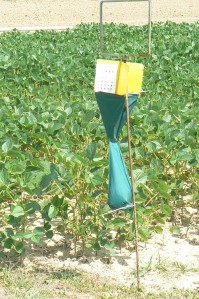By Melanie Filotas, Specialty Crops IPM Specialist, OMAFRA and Hannah Fraser, Entomology Program Lead – Horticulture, OMAFRA
With the dog days of summer upon us, it’s once again Japanese beetle season. Adult beetles are active in much of southern Ontario. In many horticultural crops, Japanese beetles can be controlled with insecticide sprays, however for some specialty crop growers, there are no registered products for this pest, or available products are very expensive. At this time of year, we get a lot of questions about non-chemical management options for Japanese beetles.
In this case, it helps to have a basic understanding of the biology of this pest. The adults start to emerge from the soil in June, and remain active into August, congregating on the leaves, flowers and fruit of over 300 plant species to feed and mate, often in large numbers.
They can fly considerable distances between host plants and egg laying sites, which are typically sunny areas with adequate soil moisture, moderate soil texture and short grass. The eggs hatch into grubs (larvae) within 2 weeks and feed on roots in the soil into the fall, moving deeper into the soil as temperatures drop to overwinter. Grubs move back up as temperatures rise in the spring and feed in the soil again for 1-2 months before pupating into adults.
The key points to take from this are (1) the adults and grubs feed on different food sources and are present at different times and (2) they are landscape-level pests, meaning that controls implemented on your land will only affect insects present there, so more beetles can continue to move in from other areas where controls were not implemented. Both these factors influence control options.
Figure 1- Japanese beetles aggregating on hazelnut leaf
Manage your environment to make it less attractive
As mentioned previously, adult females prefer short grass and moist soil to lay their eggs. Avoid grassy row middles or grassy areas around or adjacent to fields, and if at all possible, manage irrigation to restrict soil moisture to just the crop row itself during egg laying periods.
While Japanese beetles have an extremely wide host range, there are certain plants and cultivars that they prefer over others. These include members of the rose and maple family, birch, mountain ash, linden, elm, flowering crabapple, hollyhock, and many fruits including cherries, peaches, plums, grapes, blueberries and walnut. If possible, do not locate your crop close to these plants. Manage weeds that are attractive to Japanese beetles including wild raspberry, blackberry, Virgina creeper, wild grape or sassafras.
You may find that certain cultivars are less attractive to beetles. In studies of Ontario hops, University of Guelph researchers have found that Japanese beetle damage is most severe on the cultivars Hallertauer and Northern Brewer, and least severe on Chinook, Cascade and Bertwell. Similarly, some varieties of apples appear to be more attractive to Japanese beetles, such as Honeycrisp.
Physical removal of beetles
If you have a small area of a lower-growing crop, removing beetles by hand and depositing them into a bucket of soapy water can reduce populations. This should be done as soon as Japanese beetles begin flying, because plants damaged by beetle feeding release compounds into the air that actually attract more beetles.
If you can remove Japanese beetles before there is significant feeding on your plants, some (but not all) of the incoming beetles may be attracted elsewhere, to plants with more damage. While this method is obviously not practical for very large trees or plants like hops (where beetles are feeding too high to easily remove), and can be time consuming, at the Simcoe Research Station we have found daily removal of beetles to be a relatively effective means of controlling beetles on our research plots up to an acre in size. Growers with no other control alternatives will have to determine whether the increased cost of labour associated with hand removal outweighs the loss in yield due to heavy damage.
Trapping to manage Japanese beetles – beware the “spillover effect”
Japanese beetle traps consist of a blend of sex and feeding lures (pheromones) on a plastic top attached to a jar or bag. The idea is that beetles are attracted to the pheromone, fall into the bag and cannot get out. These traps are highly effective at attracting large numbers of beetles, and are marketed for monitoring and trapping. However, you don’t really need traps to monitor for Japanese beetles because they are easily spotted on crops due to their large size and tendency to aggregate.
Figure 2 – Japanese beetle trap
Their value for trapping beetles away from crops is the subject of debate, and is generally discouraged in many publications. Some reports indicate they may be useful to help manage small, isolated populations – but this doesn’t really apply to southern Ontario, where these beetles are widespread.
Where Japanese beetles are well established, several studies have shown that the traps actually attract greater numbers of beetles than the crop would have alone, and may attract more beetles than are actually caught in the trap. Researchers call this the spillover effect. They speculate that the reason may be that some female beetles are drawn more to the general area that the feeding lure’s scent is coming from rather than the exact location of the lure, and then some of the males are drawn to these spillover females rather than the sex lure in the trap.
The net effect is that the traps effectively pull beetles in from the surrounding landscape, but some are not caught by the trap, thereby increasing both defoliation to plants and egg laying in soil immediately around the trap.
If you are going to try traps for managing Japanese beetles in a crop with limited control alternatives, you need to be aware of the possible negative effect of attracting more beetles to your site and act accordingly.
- First, locate traps well outside of the crop itself, otherwise the “spillover beetles” (those attracted to the area by the lures, but not falling into the trap) will feed on your crop. Place traps downwind of the crop, ideally in a bright, open area. Height of the traps can also be important. You may need to experiment with different heights of traps to determine the most effective height.
- You may need multiple traps. We really don’t have good data on how many traps in a given area would be required to help reduce numbers of Japanese beetles at the landscape level. However a single trap will likely not be sufficient unless your crop area is very small.
- Change the bags very frequently. The bags can quickly fill up with cadavers, such that live beetles can actually use the bodies to climb out of the traps and escape. Additionally, it has been suggested that the odour of the decomposing beetles may be off-putting to other beetles, or can mask the scent of the lure. Try to check the bags at least every couple of days. When you change the bags, be aware that some of the beetles in the bags may still be alive, so seal the bags well and freeze them or bake them in the sun to ensure living beetles do not escape back into your crops.
- The chemical lures that come with the trap do lose potency over time, so change them as recommended by the manufacturer.
- Ensure that the area around the traps is not ideal for egg laying by following the general guidelines outlined in the previous section, so you don’t encourage increased egg laying near your crop. If possible, remove any “spillover beetles” (ie those that were attracted to the area but not caught by the trap) by hand picking.
Nematode products for Japanese beetle
We are often asked about nematode sprays when beetles are damaging a crop. Products consisting of pathogenic nematodes are available. They are applied to the soil to control the grubs of the Japanese beetle. They are considered biological control agents, rather than pesticides, and can be used on all crops as long as they are permitted for use in Canada. However, since these products are effective only on the grubs, and this life stage is active at a different time than the adults, applying them now will not reduce defoliation this season. These products can be applied in late summer or early fall when the larvae are active.
Nematodes require adequate soil moistures, and soil temperatures that are neither too hot nor too cold. While these products, when used properly, may reduce grub populations in your fields and therefore limit the number of beetles emerging next year, they will not stop beetles from other areas from migrating into your crop. If you are surrounded by ideal grub habitat that is not being managed, managing populations only on your field may have limited effect.
Final thoughts
Managing Japanese beetles in crops with limited registered controls can be a challenge. Following the guidelines above may help, but not eliminate, the problem. One final note to consider is that Japanese beetle damage, while unsightly, may not always require management. While direct damage to the harvestable portion of the crop will always be a problem, many plants can tolerate considerable amounts of defoliation without significantly affecting crop yield. For most crops, there are no scientifically established thresholds for Japanese beetles so ultimately, whether to intervene will largely depend on each grower’s comfort level.
Considerations will include the part of the plant being damaged (harvestable versus non-harvestable), the amount of defoliation, the size of the plant (ie young trees can tolerate less defoliation than older ones) and the general health of the plant (plants stressed by other factors such as disease, nutrient or water deficiency will likewise be less able to tolerate defoliation).
 Ontario Hop Growers' Association The OHGA is a not-for-profit association of hop growers, families and enthusiasts who are interested in supporting the growth of the hop industry in Ontario.
Ontario Hop Growers' Association The OHGA is a not-for-profit association of hop growers, families and enthusiasts who are interested in supporting the growth of the hop industry in Ontario.



